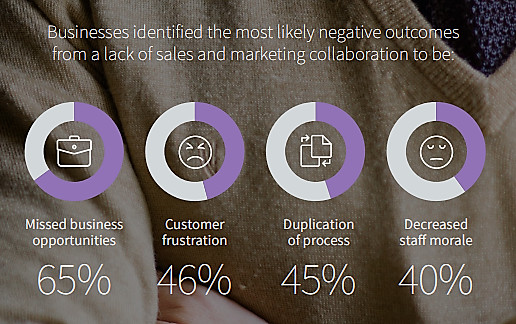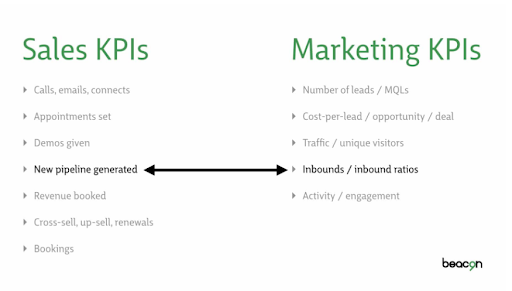

It is a well-known practice that sales and marketing strategies are created by two different sets of minds but towards one common goal - business growth. But today, it’s not only the purchasing process that has changed but also the strategies that once used to work so effectively for every business.
According to The Payoffs of Improved Sales & Marketing Alignment, US businesses lose $1 trillion a year due to sales and marketing misalignment. Unbelievable, right? This is why the discord between the strategies employed by the sales and marketing teams need to be relooked at.
Smarketing isn’t just a fusion of the words “sales” and “marketing” but it also denotes one practice with a common goal of closing more business. The Aberdeen group in its CMO’s Agenda report has found that blending in the two teams results in generating 32% higher revenue, 36% more customers, and 38% higher win rates.
Keeping that in mind, here are a few steps that you can take to align your sales and marketing strategies. Take a look.

When it comes to aligning two teams with different thought process and style of working, the best thing is to focus on what they share in common. Sales and marketing teams both have a common objective - generating quality and loyal customers who stay for a long time with your brand. So, instead of separating the tasks, make them connect with each other to see the big picture.
Inculcate this in their minds right from the beginning - to focus on “us” and not on “you” and “me”. Schedule their meetings together for discussing what’s needed for generating quality leads and retaining loyal customers. When they empathise with each other and understand the depth and gravity of the kind of work they do, working together becomes fruitful.
For the most successful sales and marketing strategies, create a single customer experience and have a clear idea of following a single need-based strategy for driving traffic and satisfying the current customers. Tie everything together as an experience and let both the teams track the progress of each prospect right from the top of the marketing funnel all the way to the bottom. This strategy will give them a holistic view of the customer journey and make them understand the struggles each team used to have at various stages and there we go, right back at the empathy part. This is where team building happens right from the core.

To beat the challenges in this new strategy, technology has played a huge role. CRM, analytics, marketing automation, and email marketing have come out as a boon to let the teams share a single platform and be on the same page for almost everything.
One of the most common reasons for discord between the sale and marketing teams is not knowing who to sell the products and services to. Defining the ideal customer is very crucial for getting both the teams on the same page. In many intances, the leads generated by the marketing team are not exactly what the sales team expects. The main reason is that they both have a different image of the prospects and customers.
To resolve this issue, create a document that explains the ideal buyer persona your brand wants to target and share it with all the team members. Any updates and modifications would then be easily accessible by them, leaving no room for confusions.
Let’s say you have almost brought the teams in alignment but how would you measure their performance? As both teams work differently, so are their performance indicators. While the sales team’s performance is measured quantitatively, such as new accounts, revenue generated, upselling, and the number of deals closed; the marketing team gives qualitative outputs which include lead quality, brand awareness, and so on. To sort this out, you can create a document that measures and records joint key performance indicators (KPIs). By doing this, you’ll be able to track how much the teams are in sync and analyse collaborative business growth.

If the product that the marketing team portrays is different than what the sales team is talking about to the potential customers, you have a big problem. As a normal human tendency, the buyers have the fear of the unknown and they do not jump to conclusions until they are very sure about a brand. In such a scenario with more aware customers, if the two teams confuse them, gaining their trust is very less likely.
To avoid this, ensure that both the teams understand what they’re selling and sending consistent messages based on the marketing team’s study on customer behaviour and needs.
Mostly, the sales team doesn’t have a clear idea of what type of content to send and relies pretty much on the marketing team. In companies with highly aligned sales and marketing teams, each member knows exactly what to send to the hard-earned leads. Thus, they have far higher closing rates and revenue generation.
To make your business grow, collaborate the two teams and let them discuss the content to be created and how exactly should it be used to increase sales and improve the quality of the leads. Also, ensure that new content is being discovered from time to time and that the sales team is involved in this process.
Misaligned sales and marketing teams misalign strategies as well. Aligning the two teams may sound a little difficult but that’s a seed if sown and watered with the right technique would give a big fruit-laden tree. Incorporate CRM and leverage dashboard reporting for better efficiency and collaboration, get them to meet often and brainstorm content, strategies, and visions together.
How do you make sure sales and marketing strategies are aligned at your organisation? Have you faced any issues? How did you resolve them? Share with us in the comments below.
Still figuring it out? We are happy to help.